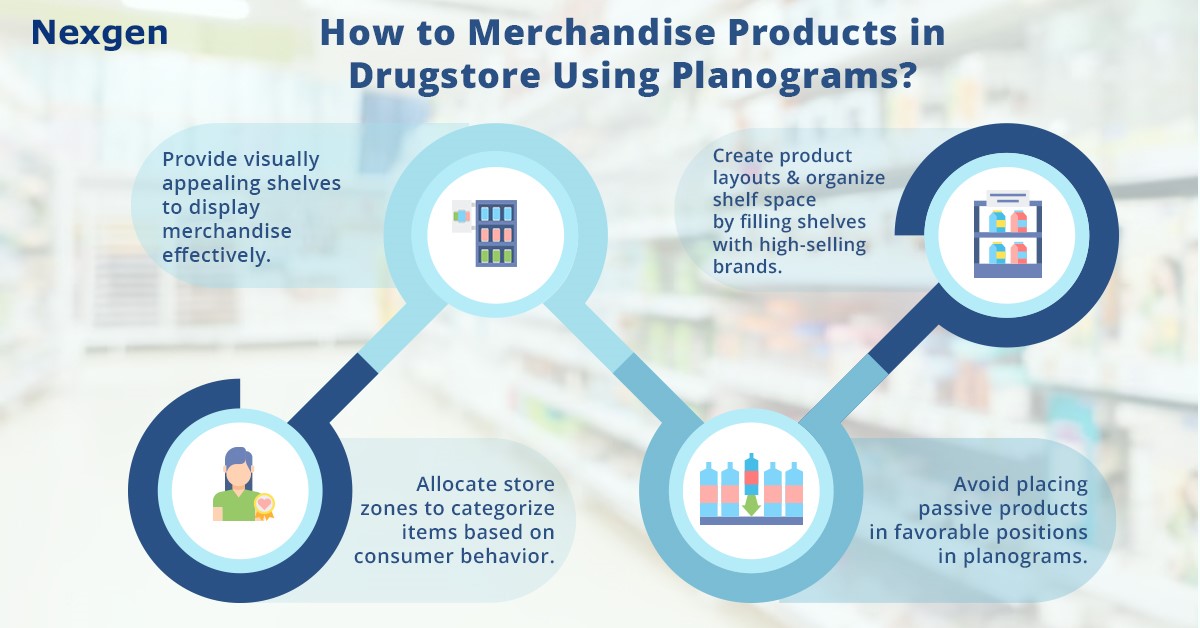The importance of retail merchandising in a drugstore cannot be understated. Most people do not often enter drugstores to look around. It is the only kind of store that comes to mind where a shopper does not always go in with the intention of making a purchase. Your customer is there to complete an errand; therefore, a more practical and convenient solution is required.
The main feature of the drugstore is its product assortment. Instead of selling cosmetics and healthcare items, most drugstore chains now sell household cleaners, over-the-counter medications, and nutritional supplements. In American supermarkets, nutritional supplements and medications constituted 20% of the selection. As a result, drugstores carry a wide range of products, each requiring special attention. Retail outlets must regulate assortments and create displays for each product category. The key to creating an enjoyable shopping experience for customers is to have a visual merchandising solution such as planograms to boost sales.
The Purpose of Using Planograms in Drugstores
Merchandising products in drugstores using planograms can help optimize store layout and increase sales. Planograms are visual diagrams that help drugstore place products accurately on shelves. This helps retailers determine how to arrange products in a category by subcategory, and then each SKU within the allotted shelf space. For example, a patient experiencing a cold might first grab cough syrup, capsules, or lip care because dry lips and sore throat are the first symptoms of a cold. Planograms guide retailers in arranging products based on diverse categories and subcategories. Following are some planogram merchandise ideas you can implement in your stores:

1. Create displays that consider the store's interests and well-known brands.
Drugstores are not dependent on popular brands, such as health and beauty stores. However, product categories are brand-specific, and among these, it may be difficult to promote private-label goods and lesser-known, brands. These include cosmetics items, children's hygiene items, hair care items, and scents. For instance, 65% of customers who purchase children's hygiene goods will purchase them from a different retailer if they cannot find the desired brand in your store. The sales percentage of specific brands on a shelf can be tracked using planograms. This will help you create product layouts and organize shelf space by filling the shelves with high-selling brands.
2. Categorize the store space based on consumer aspects.
The layout of the store is determined by understanding customer psychology and merchandising concepts. You can allocate store zones for vitamins, beauty products, or dietary supplements. Placing popular items at the end of the store, away from the checkout counters can prompt customers to walk past the entire store, making several impulse purchases along the way. Displaying promotional and seasonal items such as face masks, mini shampoo bottles, or moisturizers at the checkout counters is a profitable way to boost sales. In addition, placing a small assortment of food products, such as soft drinks, chocolates, or refreshment candies, can encourage shoppers to make impulse purchases. Additional parameters should also be considered when setting up a store layout. Divide products, for instance, according to users' age, gender, and purpose. For example, men's and women's shaving products should be kept apart, as should foot care products and anti-aging treatments. If possible, categorize products according to more specific traits like skin or hair type to offer a wider selection of items.
3. Avoid placing passive products in favorable positions in planograms.
The layout of the store must be organized considering the potential of various products. If you provide favorable shelf space to certain dietary supplements, do you really make the most profit from them? Or will a different product eventually generate more profit? To understand this, it is crucial to ensure that your planograms do not include passive products, and that your assortment meets the needs of shoppers. This will help you encourage shoppers to make purchases and boost sales.
Overview of Nexgen POG
Nexgen POG is a robust and user-friendly cloud-based visual merchandising tool. It is designed for quick and efficient planogramming with minimal effort. Planogram in retail can be designed by easily dragging and dropping the products. The multi-device compatibility feature of POG allows you to obtain, share and edit planogram on any device, including your phone. It helps in designing store-specific planograms for increased product visibility and sales.
Get Your Free Trial Now!